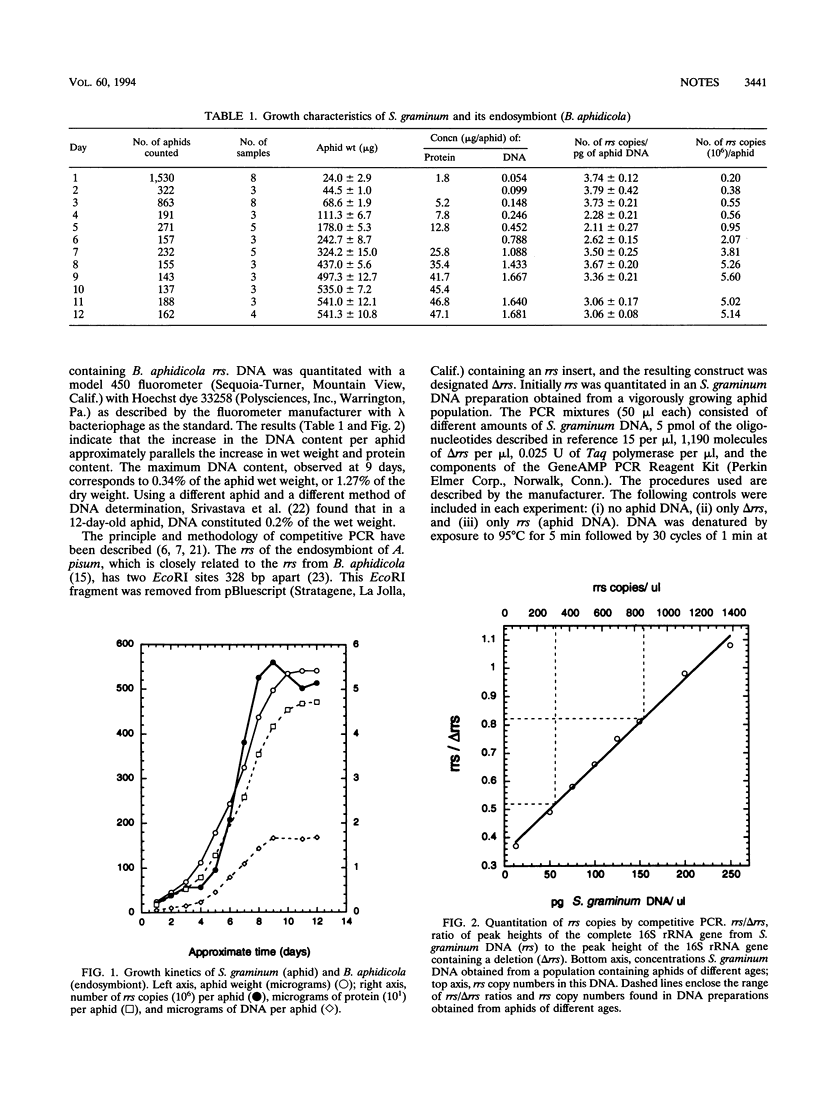Abstract
The aphid Schizaphis graminum is dependent on its prokaryotic endosymbiont, Buchnera aphidicola. As a means of determining B. aphidicola numbers during the growth cycle of the aphid we have used the quantitative PCR to measure the number of copies of rrs (the gene coding for 16S rRNA, which is present as one copy in the B. aphidicola genome). In addition we have measured the aphid wet weight and the DNA and protein content. The results indicate an approximately parallel (23- to 31-fold) increase of these properties during the period of aphid growth. A 1-day-old aphid (24 μg [wet weight]) has 0.2 × 106 copies of rrs, while a 9-day-old aphid (497 μg [wet weight]) has 5.6 × 106 copies. The coupling of endosymbiont and aphid growth is consistent with the requirement of the endosymbiont for growth and reproduction of the aphid.
Full text
PDF



Selected References
These references are in PubMed. This may not be the complete list of references from this article.
- Boyko W. J., Schechter M. T., Craib K. J., Willoughby B., Douglas B., Sestak P., McLeod W. A., O'Shaughnessey M. The Vancouver Lymphadenopathy-AIDS Study: 7. Clinical and laboratory features of 87 cases of primary HIV infection. CMAJ. 1987 Jul 15;137(2):109–113. [PMC free article] [PubMed] [Google Scholar]
- Douglas A. E. Mycetocyte symbiosis in insects. Biol Rev Camb Philos Soc. 1989 Nov;64(4):409–434. doi: 10.1111/j.1469-185x.1989.tb00682.x. [DOI] [PubMed] [Google Scholar]
- Gilliland G., Perrin S., Blanchard K., Bunn H. F. Analysis of cytokine mRNA and DNA: detection and quantitation by competitive polymerase chain reaction. Proc Natl Acad Sci U S A. 1990 Apr;87(7):2725–2729. doi: 10.1073/pnas.87.7.2725. [DOI] [PMC free article] [PubMed] [Google Scholar]
- Ishikawa H. Biochemical and molecular aspects of endosymbiosis in insects. Int Rev Cytol. 1989;116:1–45. doi: 10.1016/s0074-7696(08)60637-3. [DOI] [PubMed] [Google Scholar]
- Lai C. Y., Baumann L., Baumann P. Amplification of trpEG: adaptation of Buchnera aphidicola to an endosymbiotic association with aphids. Proc Natl Acad Sci U S A. 1994 Apr 26;91(9):3819–3823. doi: 10.1073/pnas.91.9.3819. [DOI] [PMC free article] [PubMed] [Google Scholar]
- Munson M. A., Baumann L., Baumann P. Buchnera aphidicola (a prokaryotic endosymbiont of aphids) contains a putative 16S rRNA operon unlinked to the 23S rRNA-encoding gene: sequence determination, and promoter and terminator analysis. Gene. 1993 Dec 31;137(2):171–178. doi: 10.1016/0378-1119(93)90003-l. [DOI] [PubMed] [Google Scholar]
- Munson M. A., Baumann P., Clark M. A., Baumann L., Moran N. A., Voegtlin D. J., Campbell B. C. Evidence for the establishment of aphid-eubacterium endosymbiosis in an ancestor of four aphid families. J Bacteriol. 1991 Oct;173(20):6321–6324. doi: 10.1128/jb.173.20.6321-6324.1991. [DOI] [PMC free article] [PubMed] [Google Scholar]
- Munson M. A., Baumann P. Molecular cloning and nucleotide sequence of a putative trpDC(F)BA operon in Buchnera aphidicola (endosymbiont of the aphid Schizaphis graminum). J Bacteriol. 1993 Oct;175(20):6426–6432. doi: 10.1128/jb.175.20.6426-6432.1993. [DOI] [PMC free article] [PubMed] [Google Scholar]
- Siebert P. D., Larrick J. W. Competitive PCR. Nature. 1992 Oct 8;359(6395):557–558. doi: 10.1038/359557a0. [DOI] [PubMed] [Google Scholar]
- Unterman B. M., Baumann P., McLean D. L. Pea aphid symbiont relationships established by analysis of 16S rRNAs. J Bacteriol. 1989 Jun;171(6):2970–2974. doi: 10.1128/jb.171.6.2970-2974.1989. [DOI] [PMC free article] [PubMed] [Google Scholar]
- Wolfe C. J., Haygood M. G. Bioluminescent symbionts of the Caribbean flashlight fish (Kryptophanaron alfredi) have a single rRNA operon. Mol Mar Biol Biotechnol. 1993 Aug;2(4):189–197. [PubMed] [Google Scholar]


